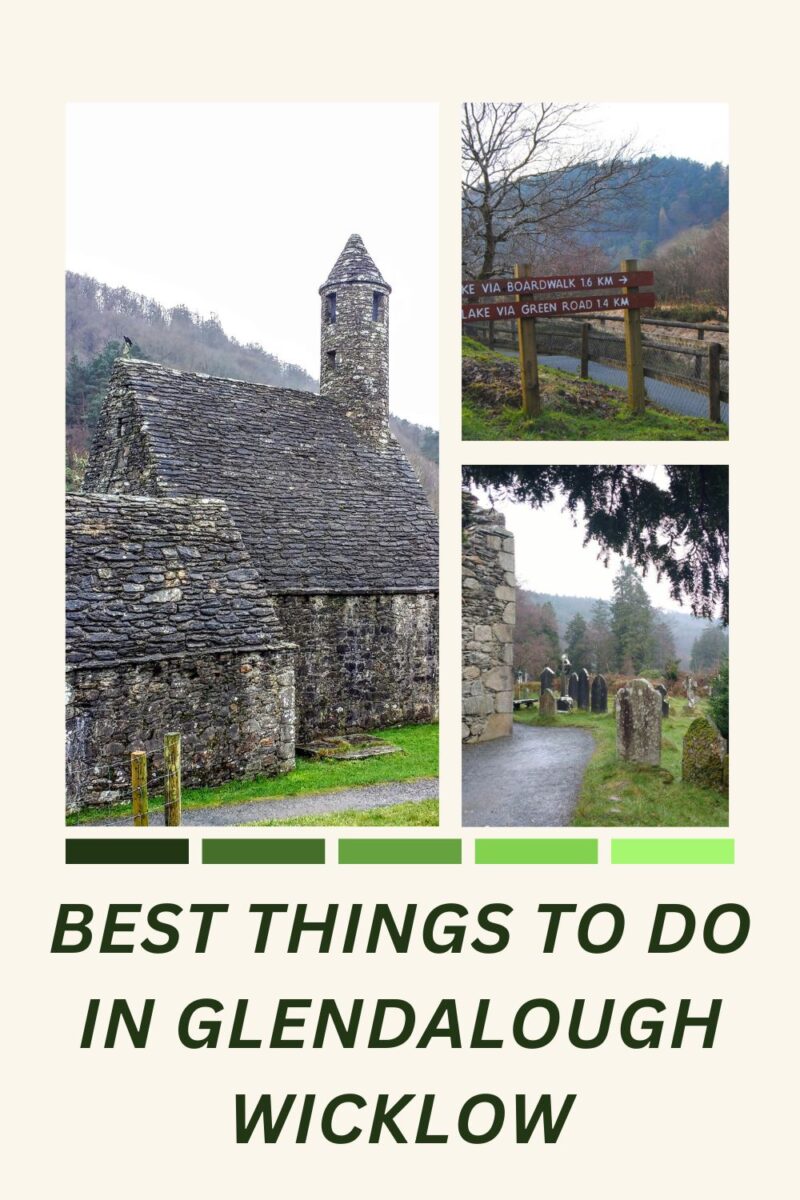Best things to do in Glendalough Wicklow 2024
Tucked into an ancient valley in the Wicklow mountains are the remains of Glendalough, an early Christian monastic settlement founded in the 6th century by St. Kevin. One of the most beautiful places in Ireland according to Lonely Planet.
If you’re looking for a peaceful and picturesque escape in Ireland, look no further than Glendalough County Wicklow Ireland. Nestled in the Wicklow Mountains National Park, this stunning valley is home to an ancient monastic city, serene lakes, and scenic hiking trails that are sure to leave you breathless. Whether you’re a history buff or an avid nature lover, there’s something for everyone in Glendalough. In this article, we’ll share our top recommendations on what to do and see during your visit to this charming Irish destination. So grab your walking shoes and get ready to explore!
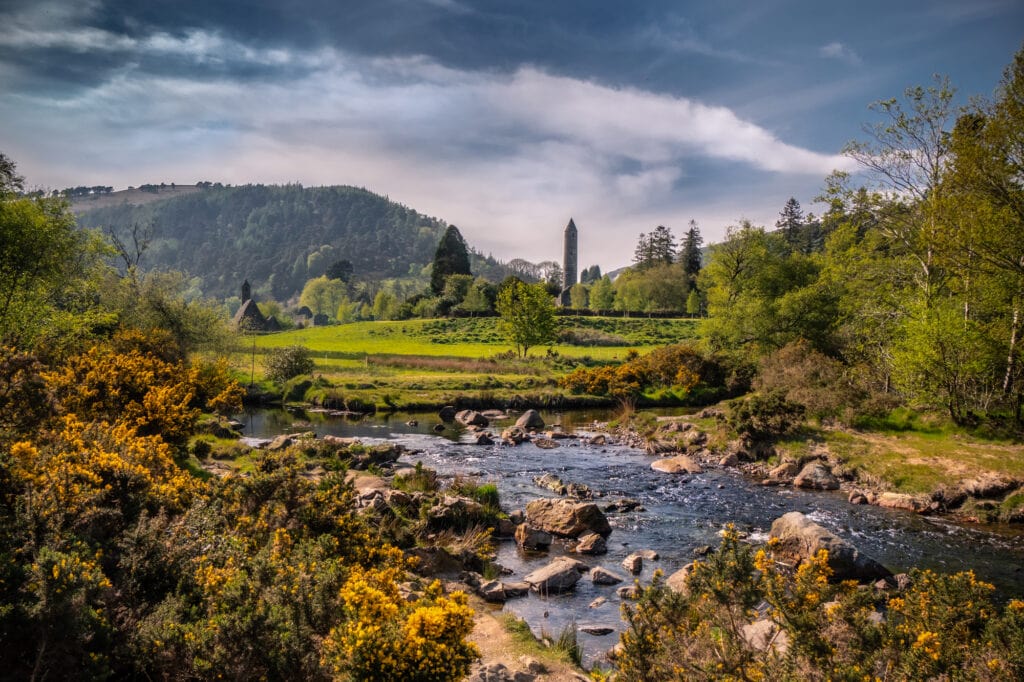
Frequently Asked Questions: Things to Do in Glendalough 2024
Within Ireland’s Ancient East lies the Wicklow Mountains National park and the Glendalough monastic site, in the Glendalough National Park with its two freshwater lakes and a river flowing throughout.
What are the best things to do in Glendalough in 2024?
In 2024, Glendalough offers a range of activities for visitors. You can explore the stunning monastic settlement, hike along the Wicklow Way, visit the top attractions such as the round tower and the Upper Lake, and discover the area’s mountain views.
How can I plan a day trip from Dublin to Glendalough?
To plan a day trip from Dublin to Glendalough, you can join a guided tour from Dublin that includes transportation, a visit to the monastic site, and stops at key attractions like the Upper Lake and the Visitor Centre.
What attractions can I explore in Glendalough?
Glendalough boasts a range of attractions such as the monastic city, the monastic ruins, Kevin’s Church, the two lakes (Upper Lake and Lower Lake), the Spinc hiking trail, and the picturesque Glendalough Valley.
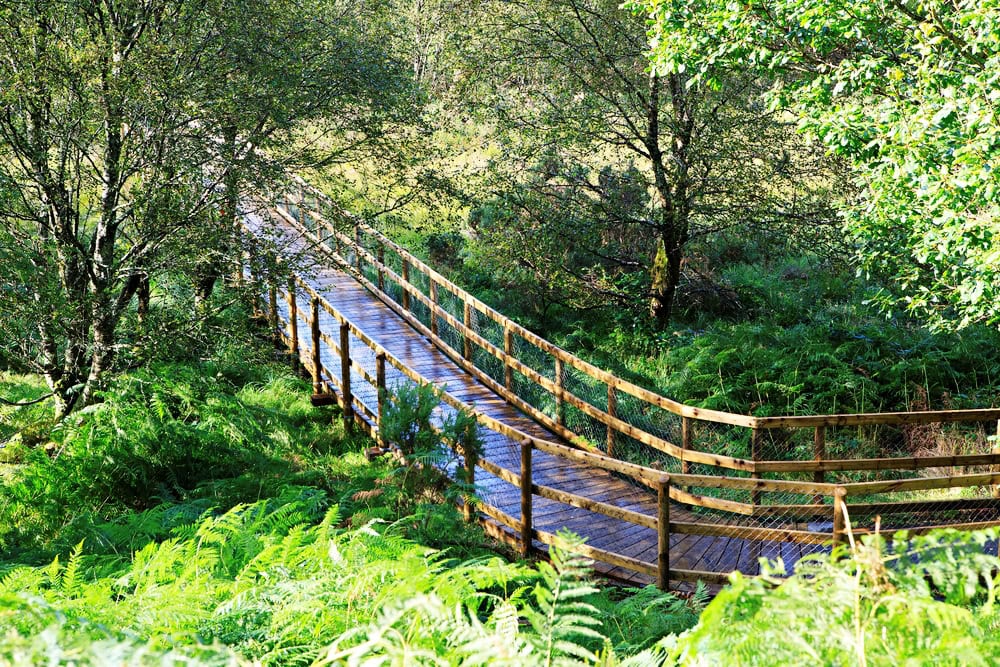
Why is Glendalough known as a must-see destination?
Glendalough is renowned for its rich history as a 6th-century monastic settlement, its stunning natural beauty within the Wicklow Mountains National Park, and the serene atmosphere that makes it a must-visit destination for history and nature enthusiasts.
How can I make the most of my visit to Glendalough?
To make the most of your visit to Glendalough, explore the monastic ruins, take a walk along the Wicklow Way, stop at the Upper Lake car park for panoramic views, and consider a guided tour to learn about the history and significance of the area.
What are the top activities to engage in at Glendalough?
Some of the top activities to engage in at Glendalough include hiking the Wicklow Way, visiting the monastic settlement, exploring the tranquil Lough Tay, admiring the round tower, and immersing yourself in the peaceful surroundings of the monastic valley.

Is Glendalough Visitor Centre worth a visit?
Yes, the Glendalough Visitor Centre is definitely worth a visit as it provides valuable information about the history of the monastic site, you can learn about the history and significance of Glendalough through exhibitions and multimedia presentations.
Is Glendalough worth seeing?
There are many things to do at Glendalough that will keep everyone happy from those who love long hikes to those visiting ancient historic sites.
What is Glendalough famous for?
Glendalough is one of Ireland’s most important monastic settlements the site is mysterious and evocative with its Celtic crosses, gravestones, ancient chapel and stone buildings.
The early Christian monastic settlement founded in the 6th century by St. Kevin and known as Glendalough is located just south of Dublin in the superb Wicklow Mountains National Park. It is easy to get to by car and there are many tours that will take you to the area as well. The area is an important part of Ireland’s Ancient East. There is no bus service in or into the park apart from the tourist tours.
Who was St. Kevin of Glendalough?
The Glendalough monastic settlement is the earliest in Irish history, founded by Kevin (Irish: Coemhghein), a descendant of one of the ruling families of Leinster. As a child, he studied under three holy men (Eoghan, Lochan and Eanna) and as a young man, he went to live at Glendalough “in the hollow of a tree.”
Kevin lived the life of a hermit in a cave, his friends were the animals and the birds and he preferred a solitary life away from his followers. He was a hermit for 7 years, went barefoot and ate very little. By 540, his fame had spread far and wide and his followers came to Glendalough and developed a seminary and monastery in his name. Eventually, Glendalough, with its seven churches, became one of the chief pilgrimage destinations in Ireland.
Map of Glendalough: Wicklow Mountains National Park
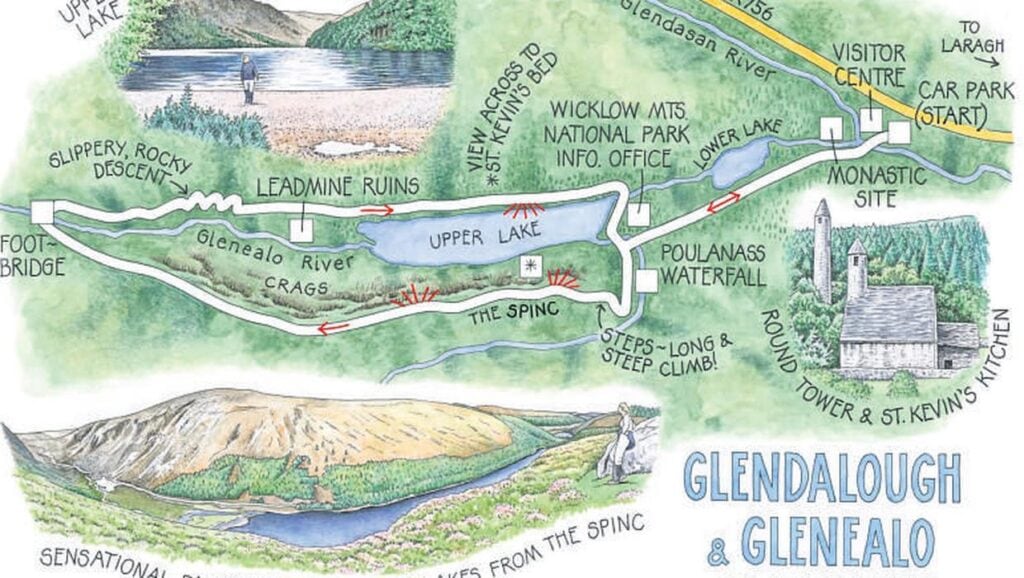
- Best things to do in Glendalough Wicklow 2024
- Frequently Asked Questions: Things to Do in Glendalough 2024
- What are the best things to do in Glendalough in 2024?
- How can I plan a day trip from Dublin to Glendalough?
- What attractions can I explore in Glendalough?
- Why is Glendalough known as a must-see destination?
- How can I make the most of my visit to Glendalough?
- What are the top activities to engage in at Glendalough?
- Is Glendalough Visitor Centre worth a visit?
- Is Glendalough worth seeing?
- What is Glendalough famous for?
- Who was St. Kevin of Glendalough?
- Map of Glendalough: Wicklow Mountains National Park
- Glendalough day trip from Dublin
- Getting to Glendalough from Kilkenny
- Map of Glendalough Monastic site
- Glendalough history
- Top attractions in Glendalough
- Glendalough entrance fees
- Things to do Glendalough
- The Lakes at Glendalough
- Glendalough Hiking and Walking Trails
- The Wicklow Way
- Where to stay in Glendalough Ireland – hotels
- Frequently Asked Questions: Things to Do in Glendalough 2024
Xyuandbeyond is reader-supported. When you buy through links on our site, we may earn an affiliate commission. You can read my privacy policy here.
Glendalough day trip from Dublin
Getting to Glendalough from Dublin without a vehicle can be a bit tricky. The drive itself is very straight forward simply Google map the trip from where ever you are in Dublin. Your best bet is to rent a car and drive from Dublin to Glendalough then you can tour or hike the Sally Gap and see all the sites where the Vikings TV show was filmed.
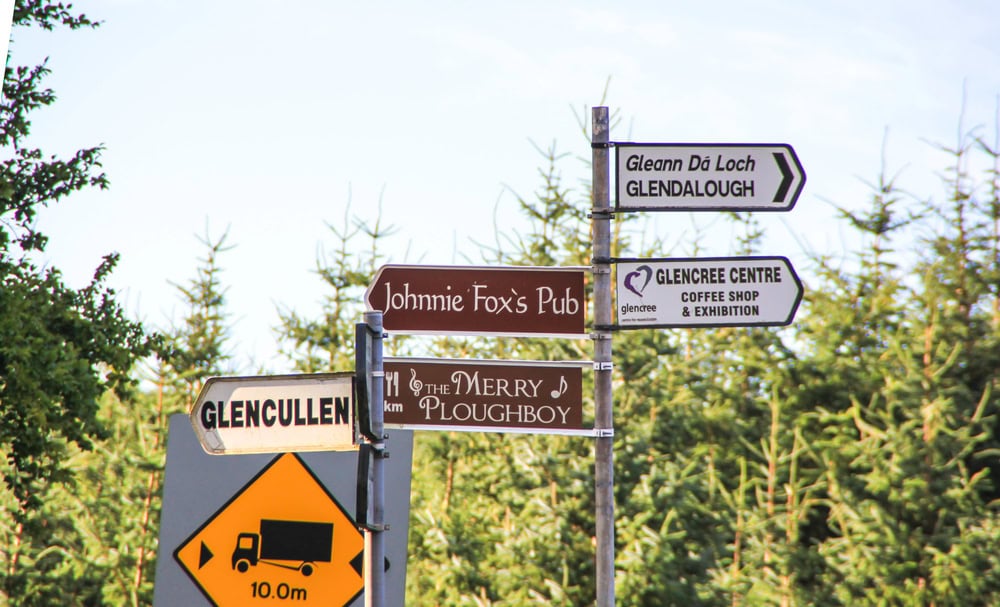
There is no direct train service to Glendalough but you can take the train from Dublin (Connolly)/Wexford as far as Rathdrum (the nearest train station to Glendalough) and then take a taxi from Rathdrum to Glendalough.
There is a private bus tour company that does trips to the Glendalough Visitors Centre with the Glendalough bus company which picks up at various stops in Dublin and costs around € 20.00 for a return fare and € 13.00 for a one way.
There are also a variety of tours available from Dublin to Glendalough that include the Wicklow Mountains and Glendalough National Park.
Getting to Glendalough from Kilkenny
Traveling from Kilkenny to Glendalough involves a combination of driving and public transportation options. Here’s how you can make the journey:
By Car
The most convenient way to travel from Kilkenny to Glendalough is by car. The journey takes about 1.5 to 2 hours, depending on traffic and road conditions.
By Public Transportation
If you prefer public transportation, you’ll need to take a combination of trains and buses, as there is no direct route.
Train from Kilkenny to Dublin:
Take a train from Kilkenny (MacDonagh Station) to Dublin Heuston Station. The train journey takes about 1.5 to 2 hours.Train schedules and tickets can be found on the Irish Rail website.
Glendalough Tour itinerary to Wicklow from Dublin
For travelers short on time, this half-day tour is a convenient way to experience the beauty of the Irish countryside without having to rent a car or waste precious hours in transit. Enjoy the scenery extended out before you embark on the journey from Dublin to County Wicklow and wander around Glendalough at a pace that suits you.
Read more about Glendalough & Wicklow Mountains Half Day Morning Tour from Dublin
Map of Glendalough Monastic site
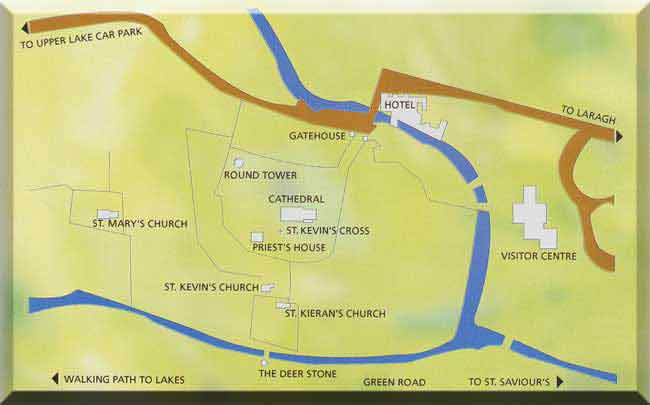
Glendalough’s Monastic site is located near Lower Lake – there is a very small parking area across from the main entryway. The medieval stone arches that you enter through are Ireland’s only surviving example of such a gateway. The arch was built with Roman-style columns and the stones were cut specifically to fit requiring no mortar to bind them together.
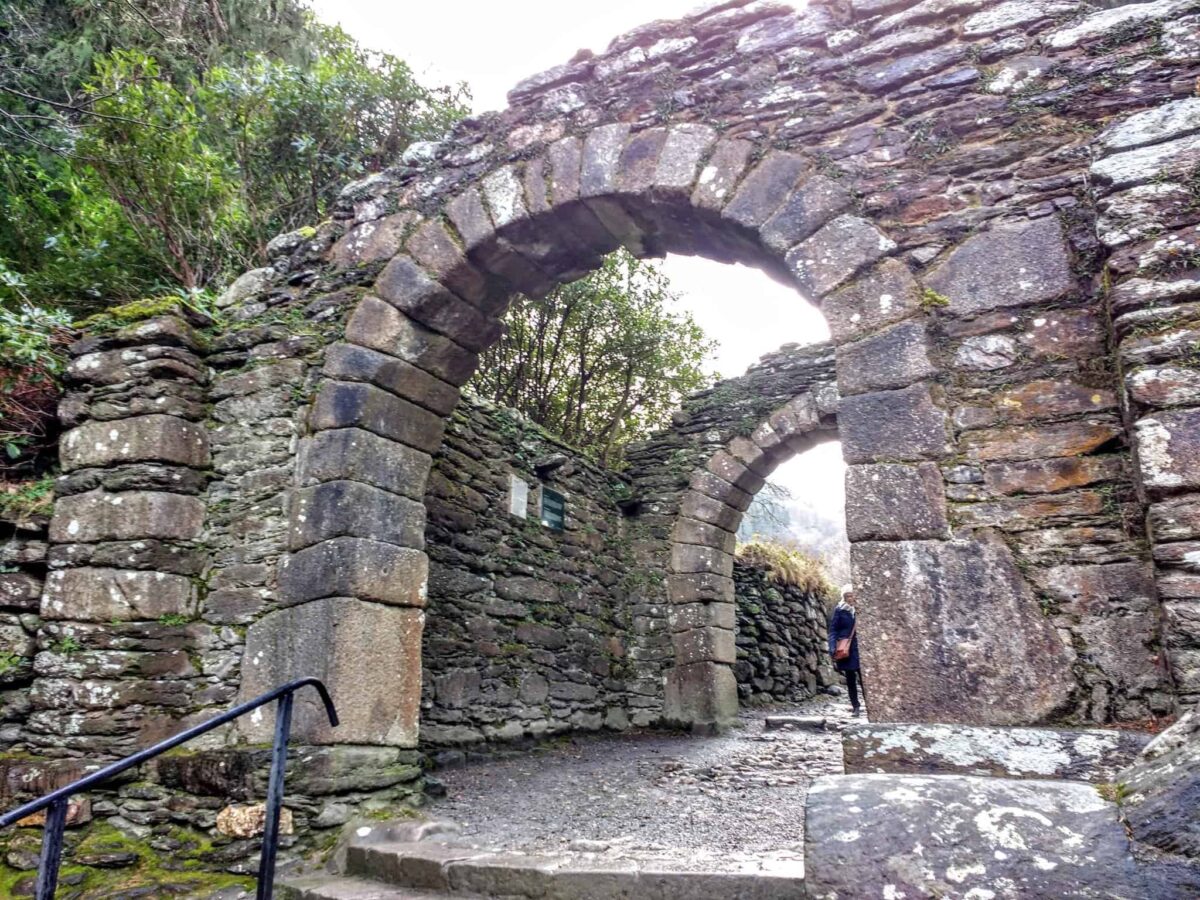
Glendalough history
This early Christian monastic settlement was founded by St. Kevin in the 6th century and from this developed the ‘Monastic City’. Despite attacks by Vikings over the years, Glendalough thrived as one of Ireland’s great ecclesiastical foundations and schools of learning until the Normans destroyed the monastery in 1214 A.D. St.
Glendalough is located in a glacial valley consisting of two lakes (the Upper and Lower Lakes) which is where the name derives from – Gleann dá Locha ‘the valley of the two lakes. Evidence for human activity in the valley goes as far back as the Neolithic Period. Recent digs have uncovered industrial activity that may date back to the founding of St Kevin’s monastery around 600AD, due to the history of the area Glendalough is not only one of Ireland’s most visited attractions but also historically one of its most important religious sites.
What are Glendalough Visitor Centre opening hours? From mid-March to mid-October the centre is open from 9.30 to 18.00 and from mid-October until March from 9.30 to 17.00 hrs.

Top attractions in Glendalough
When planning a trip, there are several must-see attractions and activities in Glendalough that you won’t want to miss. One of the top attractions is the Glendalough Monastery, a historic monastic town that offers a glimpse into the rich history of the area.
Another must-see spot is Poulanass, (on the Pink Route Walk) a beautiful waterfall located along the lake that is perfect for nature lovers. Derrybawn is another popular destination for travelers in Glendalough, offering breathtaking views of the surrounding landscape.

If you’re looking to explore the great outdoors, be sure to take a walk from the upper lake and commune with nature and explore the great hiking trails. For those coming from Dublin Airport, a stop at Glendalough is a perfect day trip destination, where you can also stop at Powerscourt Gardens on your travels in Glendalough. Whether you’re visiting Glendalough by interest in history, nature, or outdoor activities, there is something for everyone to enjoy in this picturesque town.
Glendalough entrance fees
How much does it cost to get into Glendalough?
There is no entry fee to Wicklow Mountains National Park. Entry to both the National Park and the National Park Information Office is free of charge. Please note, however, that there is a charge of €5 per car in the Upper Lake car park.
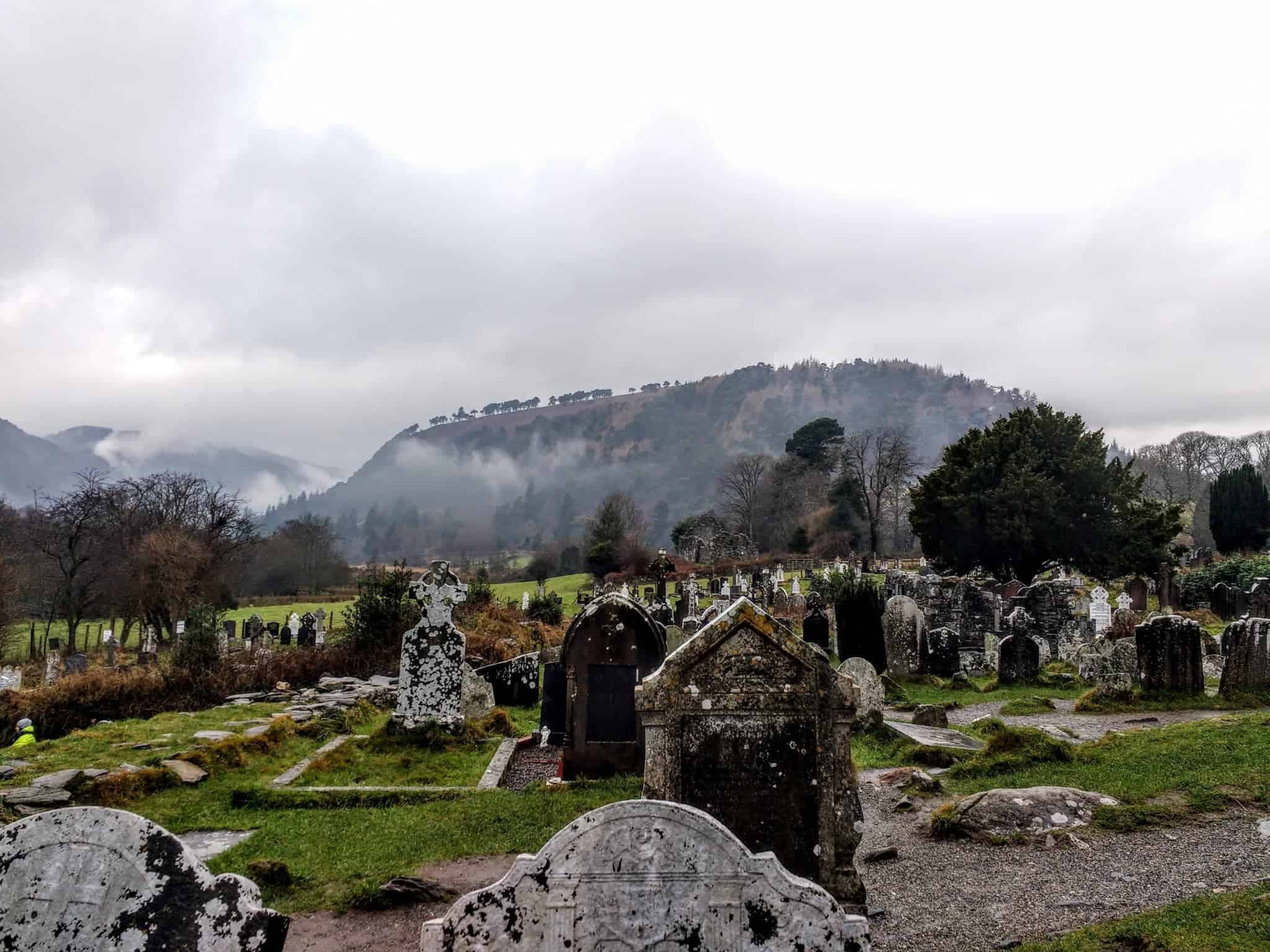
Things to do Glendalough
The oldest monastery in Ireland consists of a number of ruins and remains the tallest and most impressive being the round tower which stands over 30 meters high. In Ireland, round towers served many purposes from refuge in times of attack to bell towers and storehouses. The door of a round tower is usually around 3-4 metres above ground and accessed by a ladder that can be pulled up in case of attack. Originally the tower had six wooden floors all connected by ladders. The four stories above the entryway are lit by a small window and the top story has four windows facing the cardinal points of the compass.
Glendalough Cathedral
The largest building at Glendalough is the cathedral, with the earliest part being the nave, which is believed to have been built in the 10th century. The chancel, sacristy, and north door were added in the late 12th and early 13th centuries.
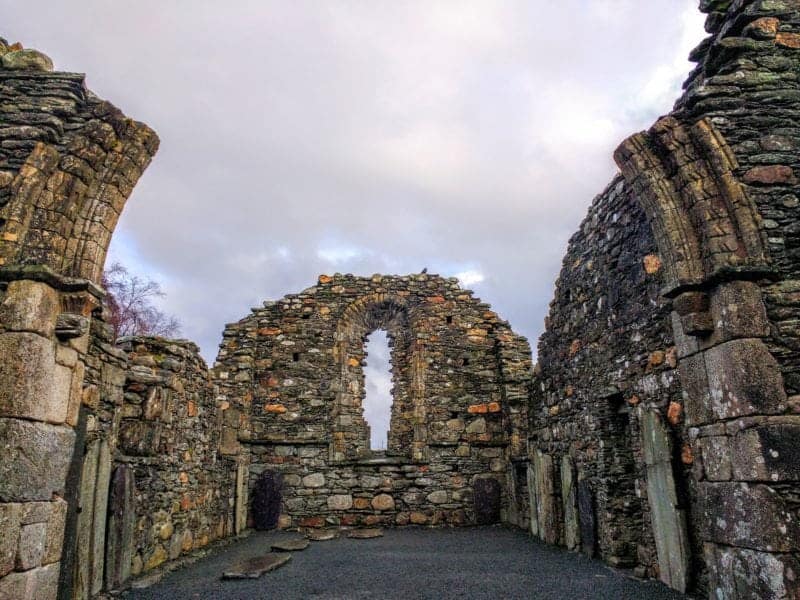
St. Kevin’s Cross
A few meters south of the cathedral is an ancient cross of local granite with an un-pierced ring, which is known as St. Kevin’s Cross.

The Priest’s House
Nearby is the Priests’ House, which has been almost entirely reconstructed from the original stones based on a 1779 sketch of the original. The original use of the building remains unknown but it may have been a resting place for the relics of St. Kevin. Its name comes from the practice of burying priests there in the 18th and 19th centuries.
St. Kevin’s Church
St. Kevin’s Church is a stone-roofed building with a round belfry with a conical cap at the west end. The church originally consisted of a simple nave with an entrance at the west end and a small round-headed window in the east gable. The incredible roof is formed of overlapping stones, supported by a semi-circular vault. The church had a wooden upper floor and the priests could get to the roof chamber through a rectangular opening on the western side of the vault.
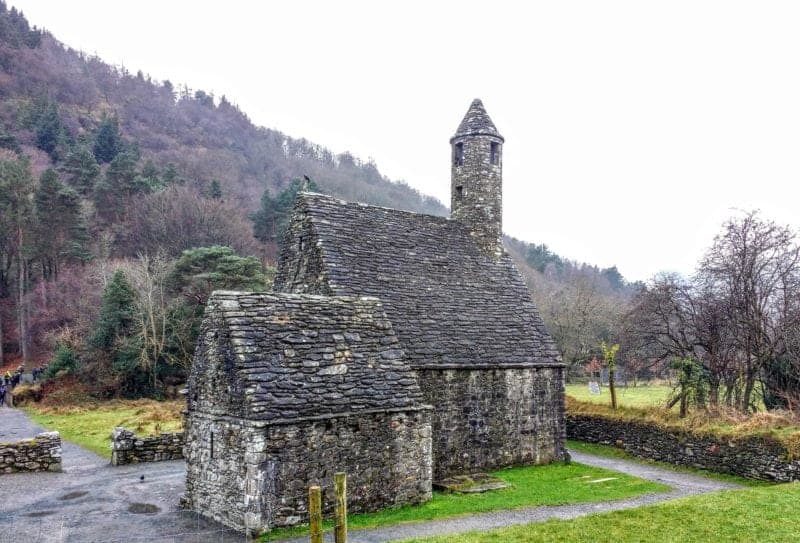
St. Kieran’s Church
Across the path are the foundations of St. Kieran’s Church, which was excavated in 1875. It is believed that the Church was built to commemorate St. Kieran, the founder of Clonmacnoise.

St. Mary’s Church
West of these buildings and accessible only from the main road is St. Mary’s Church which is also known as Our Ladies Church one of the earliest of Glendalough’s churches.
Caher
On the trail to Upper Lake, you will see the Caher, a stone-walled circular enclosure that sits between the two lakes. It is believed that it was used by pilgrims as a resting place on the pilgrimage, nearby are several crosses, which were used as stations on the pilgrims’ route.
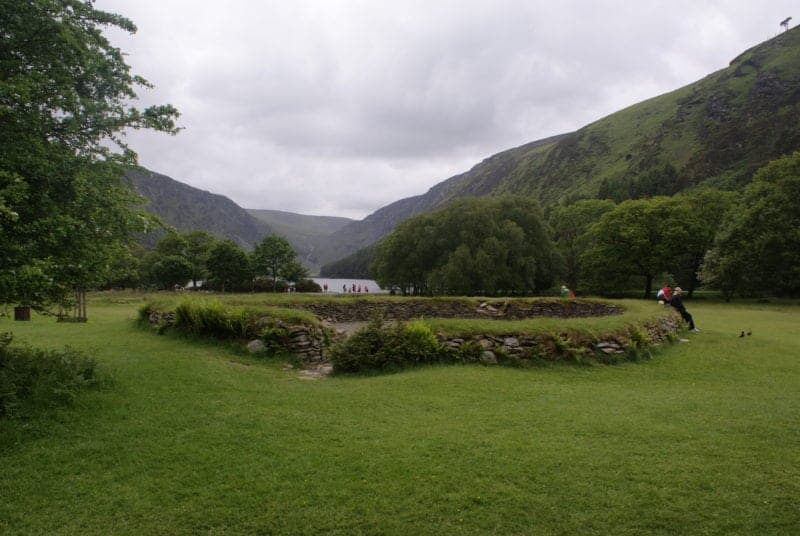
Reefert Church
Across the stream to the southwest is the Reefert Church, whose name derives from Righ Fearta, “burial place of the kings.” East of the church are two ancient crosses, one with an elaborate interlace pattern. Nearby, on the other side of the river, are the remains of another small church.
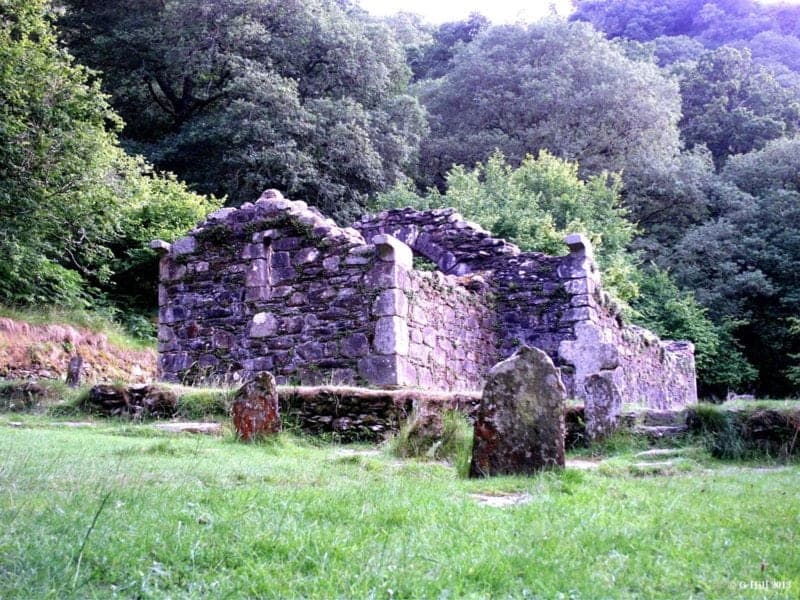
Saint Kevin’s Cell
Accessed by a steep hike to a rocky spur over the Upper Lake is St. Kevin’s Cell. Only the foundations survive, but it is thought to have been a “beehive” hut, like those on Skellig Michael and the Dingle Peninsula.

Glendalough tower
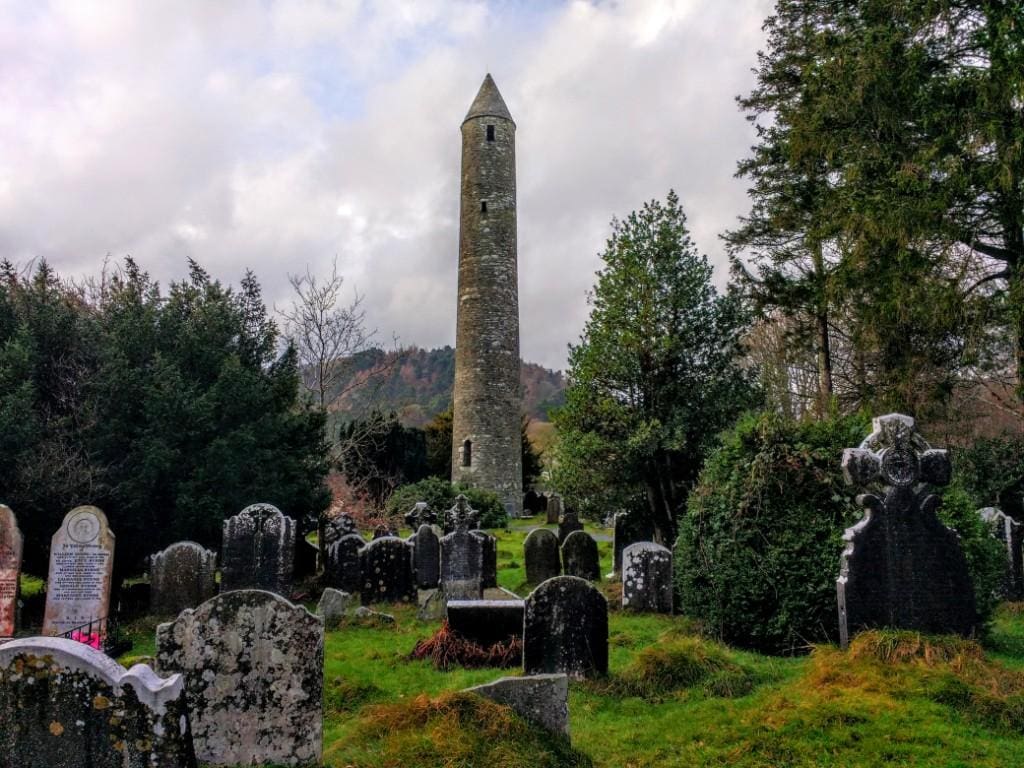
The most famous of all the landmarks in Glendalough is the Round Tower which stands 33 meters above the ground. It was built almost 1000 years ago by the monks of St. Kevin’s monastery. The conical roof had to be replaced in 1876 when it was struck by lightning.
Glendalough Visitor Centre
The Visitor Centre is located just before you arrive at the Glendalough monastic site. There is an interesting audio-visual show and a small exhibition. There are also guided tours available in both French and Spanish from the Centre.
Glendalough’s walking routes and trails are all very well marked and are accessible for a variety of abilities, although the monastic site is not accessible by wheelchairs.
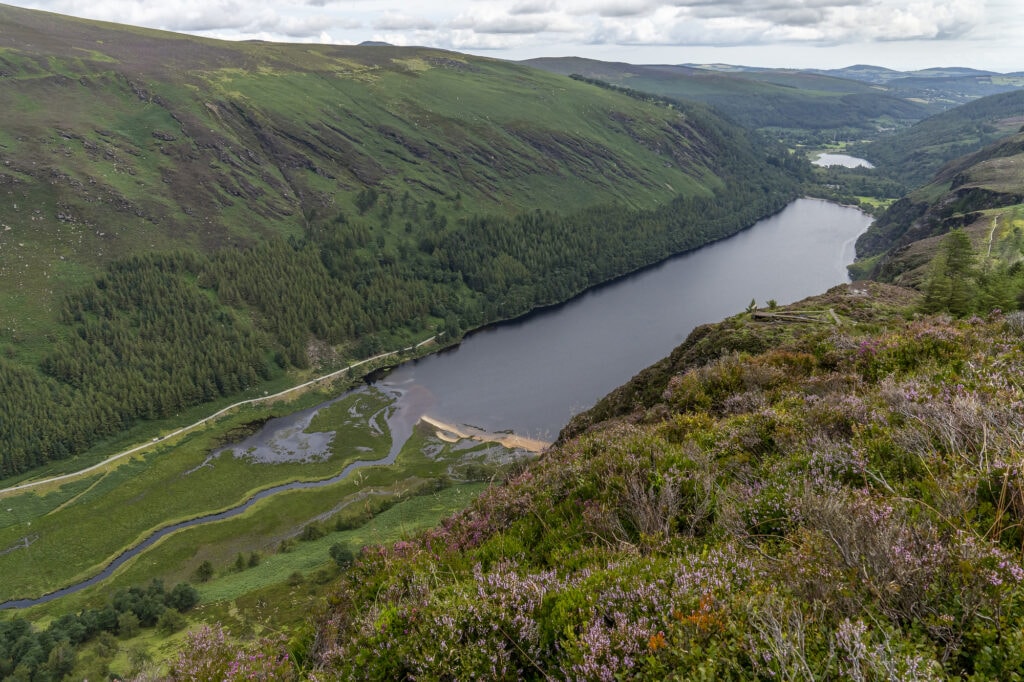
The Lakes at Glendalough
Within the Glendalough valley are the two lakes of Glendalough known as the Lower Lake and Upper Lake. The main parking area, the Glendalough Visitors’ Centre, the Glendalough Hotel, and most of the monastic ruins are located near the Lower Lake on the east end of the site.
The Upper Lake area has an overflow parking lot with washrooms, and stalls for picnics, coffee and ice cream. On a busy day, it can take over an hour to get into one of the parking lots and the place is jam-packed with both Irish and tourists. There is no fee to enter the Park but the parking costs €4 per car.
From the parking lots, the Walks are clearly outlined with signs all along the paths.
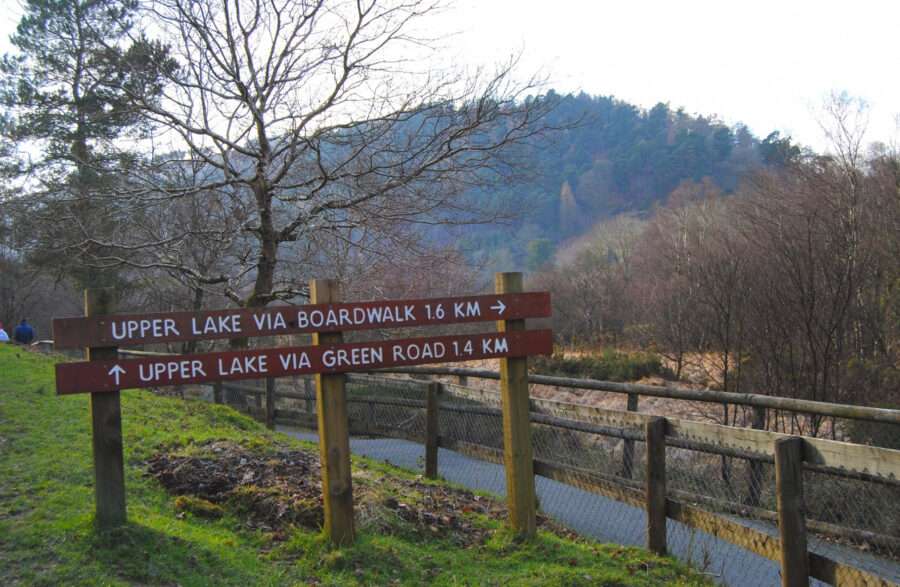
Glendalough state park map
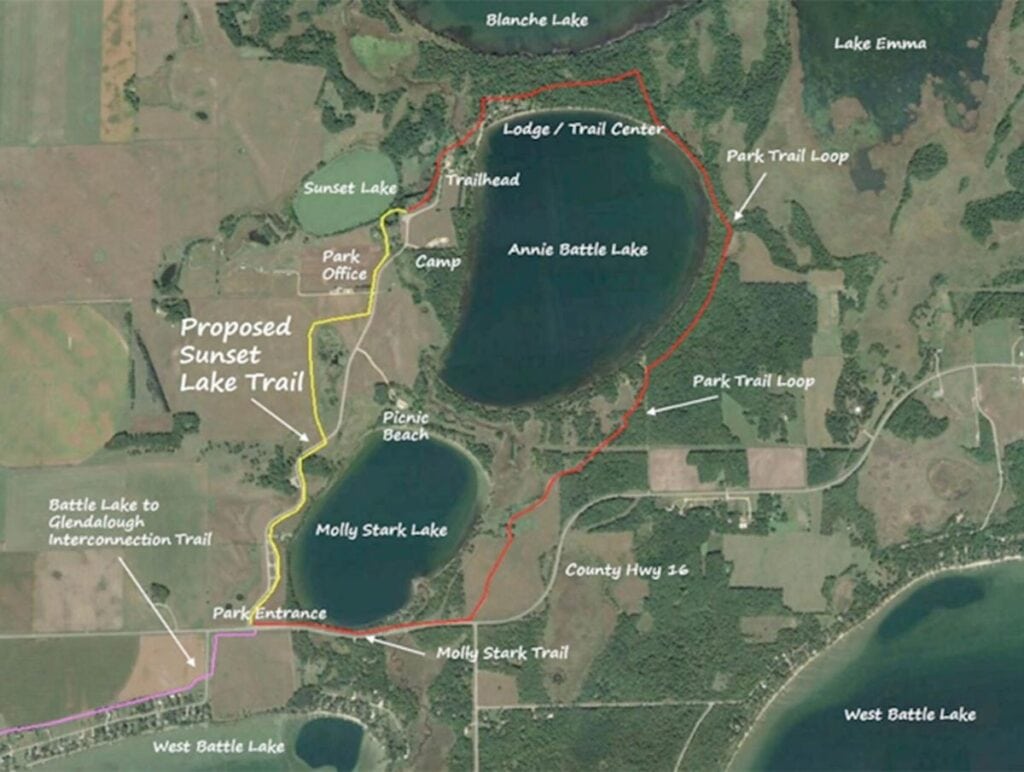
Glendalough Hiking and Walking Trails
- Spinc Ridge: A challenging hike offering panoramic views of the valley and lakes.
- Green Road Walk: A family-friendly, easy trail around the lower lake.
- Miners’ Village and Ruins: Follow the Miners’ Road to the old mining village and learn about the area’s mining history.
The 26 km section from Hollywood to Laragh is known as the Wicklow Gap Road and it is one of only two routes crossing the Wicklow mountains national park from east to west, the other being the road through the Sally Gap in North Wicklow. The road through the Wicklow Gap gives you some spectacular scenery and is truly a breathtaking drive.
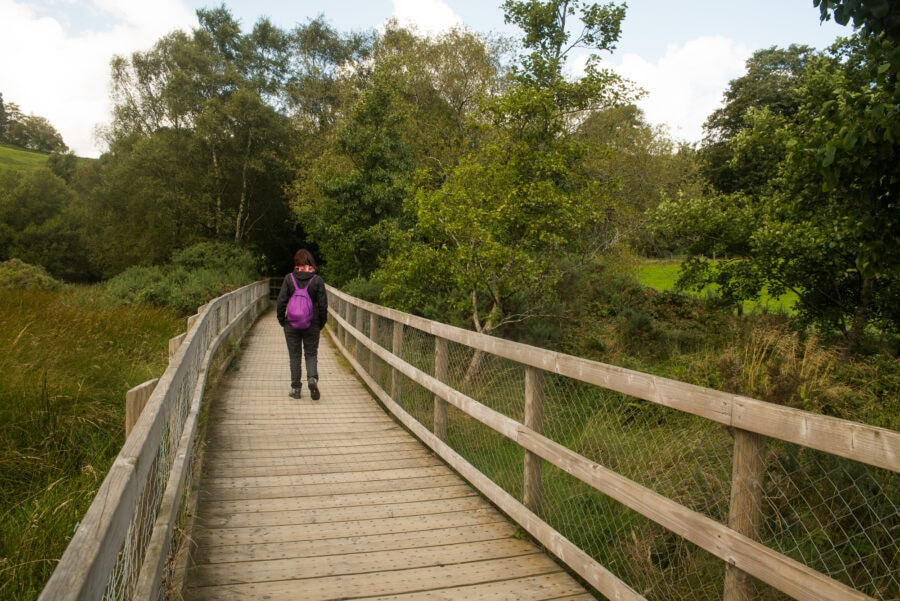
Glendalough has 9 marked walks from easy to difficult for walkers. The Visitor Centre in Glendalough sells a Trail Guide for only €0.50. The maps list the nine routes with the shortest distance being a few kilometres and the longest 11 kilometres.
Glendalough’s monastic sites are just a short drive from Dublin and there are several bus tours and private tours to the area that you can take if you don’t have a vehicle.
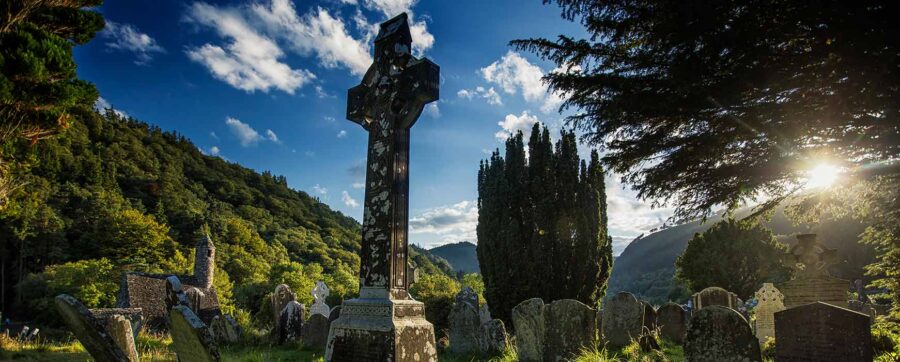
The Wicklow Way
The Wicklow Way is the oldest and most scenic walk in Ireland. It is around 130km long and crosses the Wicklow Mountains from Marley Park in Dublin, to Clonegal in County Carlow. Discover some amazing sceneries including Powerscourt Waterfall, Lough Tay (the Guinness Lake) or Glendalough.

Glendalough Irish whiskey
The Glendalough Distillery was set up by a group of friends from Wicklow and Dublin with a passion for reviving the heritage of craft distilling in Ireland. Glendalough Single malts and single grains, are all bourbon barrel aged, and finished in a second, very different cask.

Where to stay in Glendalough Ireland – hotels
Glendalough Hotel
In the heart of the Wicklow Mountains National Park, the Glendalough Hotel has of the ruined Glendalough Cathedral. The hotel offers en suite rooms, a restaurant and pub. As the Glendalough is located in a valley, most of the rooms have charming countryside and mountain views. All rooms have a work desk, hairdryer and iron.

The Glendassan serves local and international cuisine created using fresh, local ingredients. The Glendalough Tavern aims to create a friendly, Irish pub atmosphere and serves bar food. There is also a lounge with an open fire in winter.
The Bridge Tavern
The Bridge Tavern offers accommodation with free WiFi and flat-screen TV, as well as a bar. There is a fully equipped private bathroom with a shower and a hairdryer. Guests at the bed and breakfast can enjoy an à la carte or a Full English/Irish breakfast.
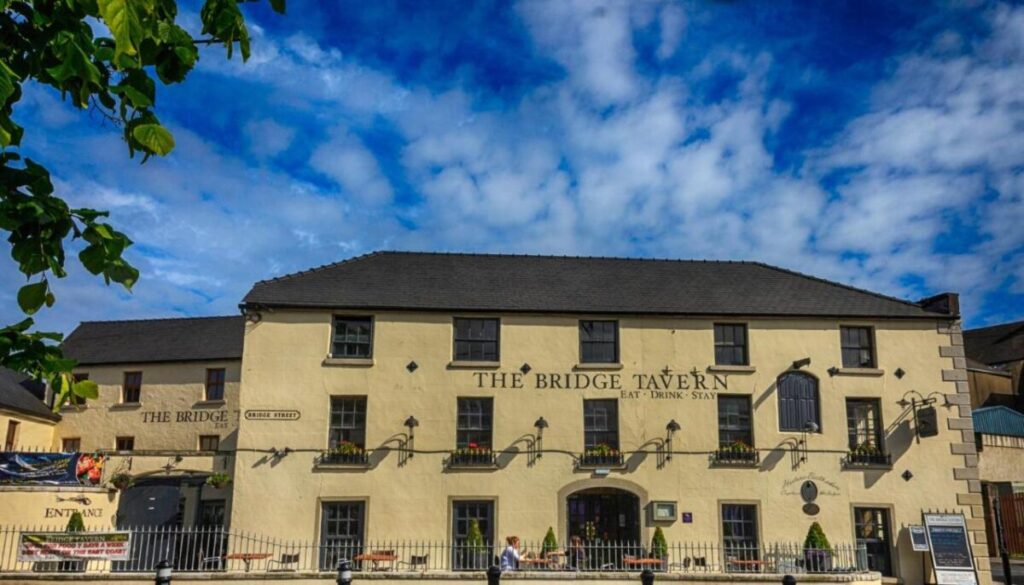
Glendalough is a hidden gem that every traveller should add to their must-visit list. From the stunning natural beauty of the surrounding mountains and lakes to the rich history and culture of the ancient monastic settlement, there’s something for everyone in this idyllic corner of Ireland. Whether you’re a hiking enthusiast, a history buff, or simply looking for a peaceful escape from the hustle and bustle of city life, Glendalough has got you covered. So pack your bags, hop on a plane (or ferry if you’re feeling adventurous), and get ready to discover the myths and legends of ancient Ireland at Glendalough.
Glendalough Co Wicklow is one of those rare places where time appears to have stopped and it should be on everyone’s Irish bucket list. What was your favourite part of visiting Glendalough?
You might also like
Planning a dream trip to Ireland? Everything you need to know
10 Ancient Celtic Holidays to Celebrate in Ireland
53 Ultimate tips for travel to Ireland Céad Míle Fáilte
Cahir Castle Ireland the best-preserved medieval castle Tipperary

